A few readers have requested where to get certain ingredients for Lao recipes. Most Asian supermarkets in any city will stock most ingredients, if you can't find it just ask, they may be able to order it in for you.
I have been reliably told that beer Lao is available in Oz - so I will get back to you once I have found an address.
Here are a few addresses for the UK.
If you like your sticky rice, you can purchase a Lao conical bamboo rice steamer, basket and pot at any Thai supermarket or try Tawana Supermarket, 18 Chepstow road, London W2. ph: 02072216316
www.thai4UK.com supplies everything for both Lao and Thai food and you can order over the internet.
www.lotusfoods.com has an interesting range of rice, like Forbidden Rice (black rice) and Bhutanese Red Rice and Lao river algae snacks - kaipen (really good toasted with jaewbong)
Tuesday 23 October 2007
Sunday 21 October 2007
Good-bye Vietnam

Well it is farewell to Vietnam and on to Cambodia. It has been an amazing journey from the North to the South. The food has been excellent throughout, Adam and I both agree, we have probably had just a few average meals in a month and that was due to the fact that we were stuck on either a boat tour without a choice of menu or too tired to go in search for something interesting to eat and just settled for second best.



If you do find yourself in Vietnam, the most important tip I can give you is eat where the locals eat, which doesn't include where all the tourists eat. The food will be of better quality, tastier, cheaper and above all else you are amongst it all and mixing with the locals. The menu won't be in English but as long as you have the basic words for duck, chicken, pork, fish and vegetables you can't go wrong - well you can but it will still be tasty.

The worst that happened to us - sitting in a bia hoi and one of the locals came over to share with us some of his grub and, yes, it was literally grub on a cracker, an entire plate of them all soft and chewy. And yes, we couldn't refuse - that would be impolite - so we both tucked in (Adam with relish)and it turned out to be quite tasty actually, and what an experience.

There are a few things I will miss, Hanoi for a start, it is now one of my favourite cities. Look beyond all the hassles and there is a lot of substance and character there, if you do visit give it more time than just a stop off along to Ha Long Bay. Have patience, you will need it, there are many touts and scam-artists but it is all worth it.

Secondly I will really miss all the yoke-ladies, they truly are amazing the way they lug all there wares about, strong, tough women, they add so much colour and character to Vietnam. If you get the chance buy something from them, a cup of tea, a meal, some fruit.



And lastly Bun Cha and Nem Cua Be, Caramel Pork and Bahn Mi would have to be the top dishes we had in Vietnam and they all happened to be in Hanoi too, I am salivating now just thinking about it. (previous blog for locations)
Here are a few of my favourite photos that Adam took of our journey, they may just inspire you to visit.


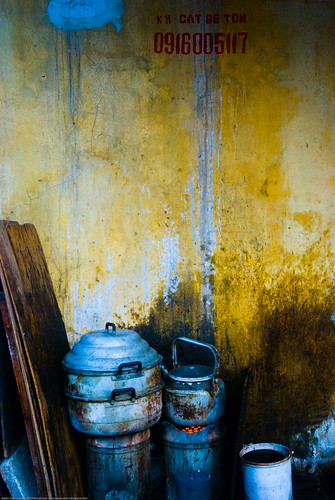
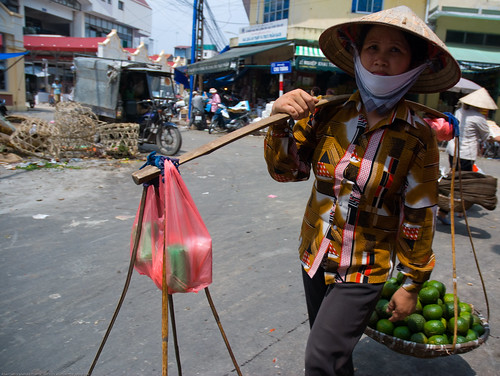
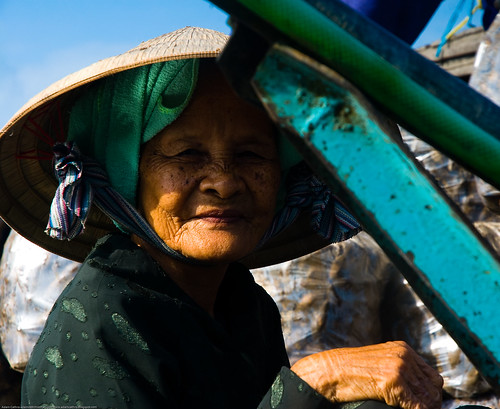

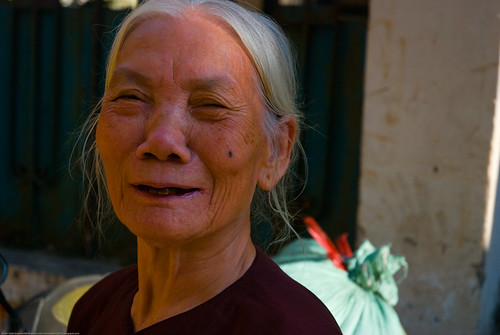
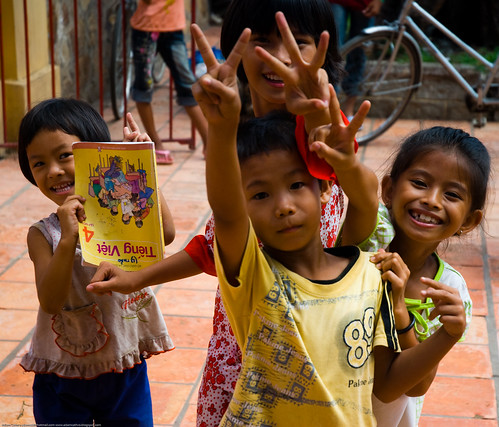
Saturday 20 October 2007
Treats in Hoi An
In Hoi An there are three dishes that particularly standout and are quite famous in the region. The first, known as the White Rose (Bahn Bao Vac) its a soft, white shrimp dumpling in the shape of a rose topped with crispy shredded onion and chopped shallots.

The second is a wonton dumpling - similar to those in Chinese cooking but the presentation is different. These are large but thin and crispy topped with vegetables. Ours had carrot, green beans, cabbage and fried onions and ginger. Both come with two dipping sauces, a chilli and a soy sauce.


The last one, and it also happens to be my favourite, is Cao Lau - a delicous noodle curry soup with thin slices of pork, fresh herbs and vegetables as well as squares of pork crackling and rice crackers scattered with pepper. What makes the Cao Lau special are the noodles, they are said to be made with special water from the Ba Le Well. The texture of the noodles is similar to that of the soba noodle they are not as soft as the pho noodle, they are served al-dente.




I have been scouring the internet for a recipe and have found only one, here since you won't be able to find the noodles outside of Hoi An you could substitute Soba noodles. The recipe is quite complex but it is worth it. Let me know how it goes.




The second is a wonton dumpling - similar to those in Chinese cooking but the presentation is different. These are large but thin and crispy topped with vegetables. Ours had carrot, green beans, cabbage and fried onions and ginger. Both come with two dipping sauces, a chilli and a soy sauce.


The last one, and it also happens to be my favourite, is Cao Lau - a delicous noodle curry soup with thin slices of pork, fresh herbs and vegetables as well as squares of pork crackling and rice crackers scattered with pepper. What makes the Cao Lau special are the noodles, they are said to be made with special water from the Ba Le Well. The texture of the noodles is similar to that of the soba noodle they are not as soft as the pho noodle, they are served al-dente.




I have been scouring the internet for a recipe and have found only one, here since you won't be able to find the noodles outside of Hoi An you could substitute Soba noodles. The recipe is quite complex but it is worth it. Let me know how it goes.



Wednesday 17 October 2007
Sweet Elixir
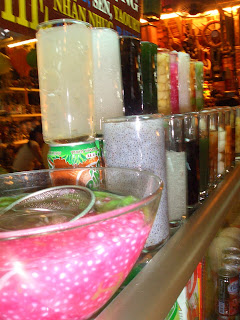
If you have a sweet tooth, you might like to try Che, a sweet soup made from essentially green mung beans. There are many variations on Che available throughout Vietnam.


In Saigon we tried Che in the local market and here it was served with at least ten ingredients all layered colourfully in a glass with ice and spoon. A cross between a cooling drink and dessert. Green mung beans in coconut milk, coconut shavings, bright pomegranate seeds, lotus seeds, sweetcorn and jellies. They are filling and a nice cooling treat after being out in the heat.
In Hue, Che is eaten as a simple sweet soup with different varieties of beans, rice, tapioca, root vegetables, lotus seeds and banana. It is enjoyed in parks and along the Perfume River banks. Its a versatile dessert because its cooling in summer yet can be also served heated in Winter.

We looked all over Hue for the sweet soup but could not find them until our last day when our motorbike drivers kindly offered to fetch us some samples to try. They came back 10 minutes later with 3 small bags of the sweet soups, che dau van - sweet soup of broad beans, a red bean and lotus seed soup and a green mung bean soup. Che is a little unusual simply because of its texture really mixed with extreme sweetness but again if you like your beans and you have a sweet tooth you will love Che.
For some of you, Winter is approaching, you might like to try this on a chilly day, it is similar to porridge - warming, sweet and filling and easy on the stomach.
Che dau Xanh - Sweet Mung Bean Soup recipe
Ingredients : Serves 4-6
225 g Skinned split mung beans, soaked in water for 3 hours and drained
500 ml Coconut milk
50 g Caster (superfine) sugar
Toasted coconut shavings (optional), to serve
Method :
*Put the mung beans in a pan and pour in 500 ml water.
*Bring the water to the boil, stirring constantly, then reduce the heat and simmer until all the water has been absorbed.
*Press the beans through a sieve, or puree them in a blender.
*In a heavy pan, heat the coconut milk with the sugar, stirring until the sugar has dissolved.
*Gently stir in the pureed mung beans, making sure the soup is thoroughly mixed and heated through.
*Serve hot in warmed bowls sprinkled with toasted coconut shavings.
Mung Beans
Buy the bright yellow, peeled, split mung beans for this soup rather than the whole green ones.
Tuesday 9 October 2007
Bow Down to the Banh Beo
A Hue speciality is Banh Beo, a snack usually eaten in the late afternoon, between 4 and 5pm. Banh Beo is served as a trayful of delights - individual dishes of steamed rice flour dough with tiny dried shrimp, spices and pork crackling and served with a sweetened nuoc mam sauce.



Banh Nam is the same but oblong-shaped and wrapped in a banana leaf and steamed.

Banh Loc is made with manioc flour instead of rice flour, so the texture changes from being soft to chewy, it is a translucent parcel of spice, whole dried shrimp and pork wrapped in banana leaf, steamed and served with a stronger and spicier nuoc mam sauce.


Ram is basically rice flour dough both steamed and fried, bite-sized and combined for the contrast in textures, served with a spicy sauce.

If you are looking for a snack in the afternoon and you happen to be on the south side of the Perfume River, Take a stroll to Hang Me - found at 45 VO THI SAU. The lady here will explain how to eat each dish, it's basic but clean and friendly.



Banh Nam is the same but oblong-shaped and wrapped in a banana leaf and steamed.

Banh Loc is made with manioc flour instead of rice flour, so the texture changes from being soft to chewy, it is a translucent parcel of spice, whole dried shrimp and pork wrapped in banana leaf, steamed and served with a stronger and spicier nuoc mam sauce.


Ram is basically rice flour dough both steamed and fried, bite-sized and combined for the contrast in textures, served with a spicy sauce.

If you are looking for a snack in the afternoon and you happen to be on the south side of the Perfume River, Take a stroll to Hang Me - found at 45 VO THI SAU. The lady here will explain how to eat each dish, it's basic but clean and friendly.
Fish Noodle soup
Inside the walled citadel in Hue, to the east of the citadel there is a special street – Duong Le Thanh Thon. It is special because in the late afternoon it starts to fill up with small roadside kitchens, they all specialise in the same dish – fish noodle soup, and it is so good you will want two bowls.

A lady sits in front of her open kitchen, a large pot of fish soup is bubbling away, with floured hands she takes a plastic cylinder in which she moulds some dough. Knife in one hand, she deftly slices thin dollops of noodles into a pot of salted boiling water.

A few minutes later, the fresh noodles are cooked and drained, tossed into a bowl. A spoonful of whitebait-sized fish fillets already cooked, marinating in a chilli, turmeric and spiced oil, and are added along with a ladle full of the most delicous fish broth and a handful of herbs.


It's rich, warming yet light, completely satisfying. I would choose this simple home-cooked meal over an Imperial feast anyday.


A lady sits in front of her open kitchen, a large pot of fish soup is bubbling away, with floured hands she takes a plastic cylinder in which she moulds some dough. Knife in one hand, she deftly slices thin dollops of noodles into a pot of salted boiling water.

A few minutes later, the fresh noodles are cooked and drained, tossed into a bowl. A spoonful of whitebait-sized fish fillets already cooked, marinating in a chilli, turmeric and spiced oil, and are added along with a ladle full of the most delicous fish broth and a handful of herbs.


It's rich, warming yet light, completely satisfying. I would choose this simple home-cooked meal over an Imperial feast anyday.

Eat like A King!
The Nguyen Dynasty ruled Vietnam from 1802 – 1945 from the Imperial City in Hue, and during this period there were thirteen emperors. The Emperor Tu Duc was the longest reigning of the Nguyen monarchs, ruling for thirty-six years. He was particularly known for being a weak ruler and how he spent his time during his reign, focusing on himself and his pleasures - which were numerous.
He enjoyed 16 years of boating, fishing, meditation and poetry, composing thousands of poems on the grounds of his (now) mausoleum. He kept himself very busy with 104 wives and a whole village of concubines. He drank tea made from dew collected from lotus blossoms and he insisted on at least 50 dishes in every meal.
He apparently didn't like eating the same dish twice in a year, so his army of chefs worked tirelessly to create many recipes to suit his wishes. Due to this, Hue cuisine has developed into thousands of dishes and is presented more elaborately than anywere else in Vietnam, here they use many small dishes so the table looks like a king's. Central Vietnamese food is all about seasonal produce as they have four distinct seasons.
The cuisine today in Hue is a combination of Hue home-cooking, tasty vegetarian dishes which stem from the Pagodas and elaborate Imperial dishes handed down through generations of Imperial cooks.



Adam and I visited Ythao Garden, an old colonial villa inside the walled citadel, one of a few that offers a sample of an Imperial menu. Our host greets us dressed in her silk ao dai at the gates of the villa and we are shown to the dining room set out amongst the garden. I am feeling a little under-dressed, as you do when you are travelling. We are shown the set menu for $8 each – there is no other menu available.


Within minutes of being seated out comes the first dish, an elaborate vegetable carving of a peacock decorated with springrolls accompanied with a dish of nouc mam (fish sauce).


Then a light vegetable broth followed by four gigantic steamed prawns with a side dish of salt, pepper and a fresh squeeze of lime. There is no breathing space, next comes Hue's speciality – a pancake filled with pork, shrimp, bean sprouts with a peanut and sesame seed dipping sauce.


We have barely finished our pancakes and out comes a fig salad – finely chopped pork with green figs, peanuts, sesame seeds, mint and coriander to be scooped onto crunchy prawn crackers. The green figs work well with the fattiness of the pork as they have a chalky flavour.

We ask for a break but a few minutes later grilled beef arrives with a beautiful parcel of steamed lotus rice. They are really in a hurry here. Our host slices the parcel open and retreats to a corner along with another four girls all dressed in ao dais sitting at a table giggling and staring at the foreigners. I feel like a caged animal in a zoo.
Our plates are cleared and at last we can have a break, relax and unwind, take our time, soak up the atmosphere, out comes dessert – fruit and a flower vase filled with two stems of green bean cake fashioned to look like fruit, too pretty to eat.
The fig salad was excellent, the rest of the dishes were good but unimpressive but great value for $8 a head. The presentation was creative and elaborate, it takes time to make each fruit and vegetable carving - an army of staff, I should imagine.
However we were so rushed through our dinner, I was really disappointed that we couldn't take our time and enjoy all the hard work to make dinner look beautiful.
So we tried a sample of seven dishes out of a possible 2,500, I get the feeling that Hue's Imperial food has been revived for the tourists and for their tastes, its all about the presentation and the atmosphere but not really about the food, I am sure there is tastier food out there, we just have to go and explore Hue to find it.
He enjoyed 16 years of boating, fishing, meditation and poetry, composing thousands of poems on the grounds of his (now) mausoleum. He kept himself very busy with 104 wives and a whole village of concubines. He drank tea made from dew collected from lotus blossoms and he insisted on at least 50 dishes in every meal.
He apparently didn't like eating the same dish twice in a year, so his army of chefs worked tirelessly to create many recipes to suit his wishes. Due to this, Hue cuisine has developed into thousands of dishes and is presented more elaborately than anywere else in Vietnam, here they use many small dishes so the table looks like a king's. Central Vietnamese food is all about seasonal produce as they have four distinct seasons.
The cuisine today in Hue is a combination of Hue home-cooking, tasty vegetarian dishes which stem from the Pagodas and elaborate Imperial dishes handed down through generations of Imperial cooks.



Adam and I visited Ythao Garden, an old colonial villa inside the walled citadel, one of a few that offers a sample of an Imperial menu. Our host greets us dressed in her silk ao dai at the gates of the villa and we are shown to the dining room set out amongst the garden. I am feeling a little under-dressed, as you do when you are travelling. We are shown the set menu for $8 each – there is no other menu available.


Within minutes of being seated out comes the first dish, an elaborate vegetable carving of a peacock decorated with springrolls accompanied with a dish of nouc mam (fish sauce).


Then a light vegetable broth followed by four gigantic steamed prawns with a side dish of salt, pepper and a fresh squeeze of lime. There is no breathing space, next comes Hue's speciality – a pancake filled with pork, shrimp, bean sprouts with a peanut and sesame seed dipping sauce.


We have barely finished our pancakes and out comes a fig salad – finely chopped pork with green figs, peanuts, sesame seeds, mint and coriander to be scooped onto crunchy prawn crackers. The green figs work well with the fattiness of the pork as they have a chalky flavour.

We ask for a break but a few minutes later grilled beef arrives with a beautiful parcel of steamed lotus rice. They are really in a hurry here. Our host slices the parcel open and retreats to a corner along with another four girls all dressed in ao dais sitting at a table giggling and staring at the foreigners. I feel like a caged animal in a zoo.
Our plates are cleared and at last we can have a break, relax and unwind, take our time, soak up the atmosphere, out comes dessert – fruit and a flower vase filled with two stems of green bean cake fashioned to look like fruit, too pretty to eat.
The fig salad was excellent, the rest of the dishes were good but unimpressive but great value for $8 a head. The presentation was creative and elaborate, it takes time to make each fruit and vegetable carving - an army of staff, I should imagine.
However we were so rushed through our dinner, I was really disappointed that we couldn't take our time and enjoy all the hard work to make dinner look beautiful.
So we tried a sample of seven dishes out of a possible 2,500, I get the feeling that Hue's Imperial food has been revived for the tourists and for their tastes, its all about the presentation and the atmosphere but not really about the food, I am sure there is tastier food out there, we just have to go and explore Hue to find it.
Subscribe to:
Posts (Atom)